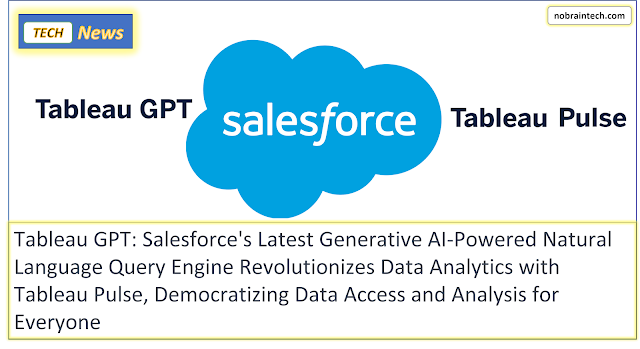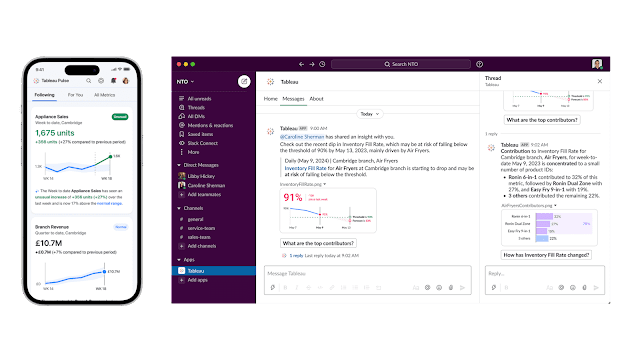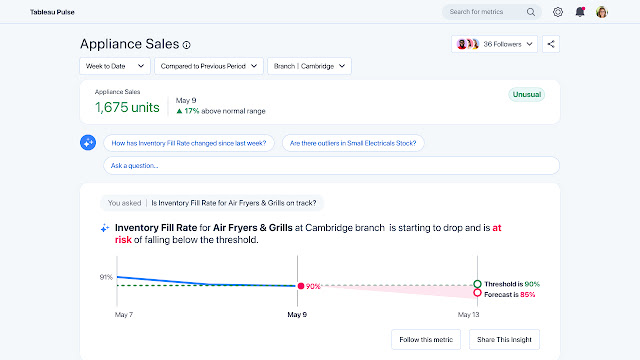Highlights
- Tableau GPT is a generative AI feature that allows natural language queries for data analysis and visualization.
- Tableau Pulse is a personalized and automated insights feature that tailors its responses based on user-defined metrics and goals.
- Together, Tableau GPT and Tableau Pulse are democratizing data access and analysis for a wider range of users, regardless of their technical or data skills.
Salesforce, the leading CRM platform, has announced a major update to its data analysis and visualization tool, Tableau, at its annual conference in Las Vegas. The update introduces Tableau GPT, a generative AI feature that allows users to interact with data using natural language queries and get insights in various formats, such as charts, graphs, and narratives.
Data is everywhere, and it is becoming more and more important for businesses to leverage data to gain insights, make decisions, and drive innovation. However, data is also complex, messy, and often overwhelming. How can we make data more accessible, understandable, and actionable for everyone? That's where Tableau GPT and Tableau Pulse come in.
Tableau GPT is powered by Salesforce's own large language model (LLM), which was developed for its AI platform Einstein. The LLM can understand complex and diverse data sources and generate coherent and relevant responses based on user preferences and context. Tableau GPT can also integrate with other Salesforce platforms, such as Slack, to deliver analytics to users where they work.
Tableau GPT is a natural language query engine that allows users to ask questions about their data in plain English and get answers in the form of charts, tables, or narratives. For example, a user can type "What are the sales trends by region and product category?" and Tableau GPT will generate a relevant visualization that shows the answer. Tableau GPT can also suggest follow-up questions or insights based on the user's query and data context.
One of the applications of Tableau GPT is Tableau Pulse, a new feature that provides personalized and automated insights to business users and data consumers. Tableau Pulse uses AI to customize the analytics experience based on user-defined metrics and goals, and delivers insights in natural language and visual formats. Users can also ask follow-up questions or request more details using natural language.
Tableau Pulse is a natural language generation tool that creates personalized and engaging stories from data. For example, a user can select a dashboard or a worksheet and Tableau Pulse will generate a summary of the key findings, trends, and outliers in natural language. Tableau Pulse can also tailor the tone, style, and level of detail of the stories based on the user's preferences and audience.
Salesforce claims that Tableau GPT will democratize data access and analysis for a wider range of users, regardless of their technical or data skills. According to Salesforce's research, 41% of business leaders lack an understanding of data because it is complex or not accessible enough, and 67% of business leaders are not using data to decide on pricing in line with economic conditions, such as inflation.
Together, Tableau GPT and Tableau Pulse are reimagining the data experience by making it more natural, intuitive, and conversational. They enable users to explore data with ease, discover insights with speed, and communicate findings with clarity. They also empower users to become more data literate and confident in their data skills.
Francois Ajenstat, chief product officer at Tableau, said that Tableau GPT will change the way people use data and make it more engaging and conversational. "We have the opportunity to change data again and empower more people to use it," he said. "It has to be easy and familiar."
Tableau GPT is expected to be available in beta in the first half of 2024. Tableau Pulse is expected to be available in pilot in the second half of 2024.
Tableau GPT and Tableau Pulse are part of Tableau's vision to democratize data and empower everyone to make data-driven decisions. They are also examples of how Tableau is leveraging the latest advances in AI and NLP to augment human intelligence and creativity. By combining the power of data and language, Tableau is creating a new way of seeing and understanding data. Read more about this at
https://www.tableau.com/blog/tableau-pulse-and-tableau-gpt














No comments: